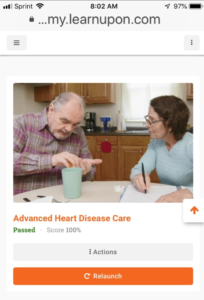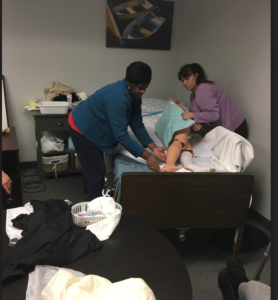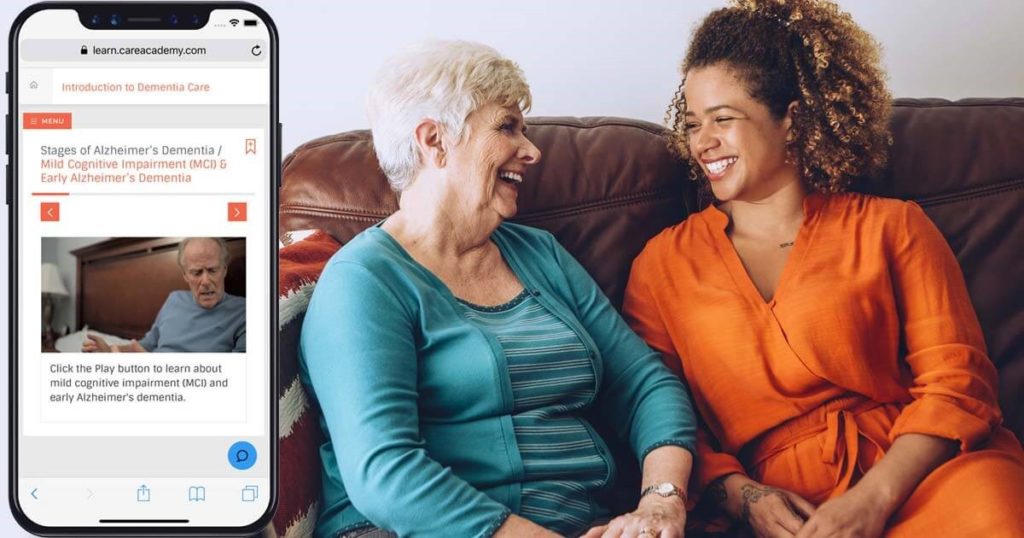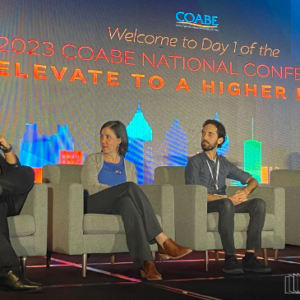Senior care is one of the fastest-growing areas of work of the US, and certified home health aides (HHA) are especially in high demand given the shortage of paid caregivers. With the population of people over the age of 65 expected to double over the next two decades, it is essential to address the shortage. MIT economist Paul Osterman, author of Who Will Care for Us?, predicts that by the year 2040 there could be, minimally, a shortage of 350,000 paid caregivers.
While the profession does not require a degree or extensive training, many adults in lower wage jobs still face barriers to accessing the training and certification required to enter this promising career pathway. Innovative approaches to training that integrate mobile technologies and fit within caregiver schedules can address this challenge – CareAcademy has done just that.
CareAcademy creates online training that empowers senior home care professionals to deliver quality service and improve the lives of older adults. To date, CareAcademy has focused on training non-medical caregivers and providing continuing education for Home Health Aides. In response to growing demand, CareAcademy developed a new curriculum to fill a crucial knowledge gap with accessible mobile learning, certification, and career advancement opportunities for new home health aides.
Funded, in part, by the The Employment Technology Fund (ETF) (a social impact fund breaking down barriers to employment for lower-income adults) and field tested by The EdTech Center with the support of Walmart, CareAcademy piloted a 6-week blended learning course leading to certification for home health aids. Their employer partner in the pilot was Best of Care in the Greater Boston area. The goal of the field testing was to determine the efficacy of this new approach, blended mobile learning to advance more of the company’s incumbent employees from domestic caregiver roles (supporting house, laundry, and grocery tasks) to certified Home Health Aides (providing more hands-on patient care such as transferring, feeding, bathing, and taking vital signs).

Each week, the in-home domestic caregivers completed 10 hours of instruction online before going to an in-
person four-hour class led by a nurse, where they practiced the skills introduced online. The caregivers accessed learning content in a web portal and Learning Management System stocked with a rich combination of videos, interactive activities, and accessible text-based resources. The modules of the course were accessible on any mobile device, and covered topics such as infection control, nutrition and meal preparation, dementia, fall prevention, and safe transfers. The expectation was that the learners had covered all content online and completed the module quizzes at over 80% before class. During the in-class session, the caregivers deepened their understanding of the course topics through collaborative activities and demonstrations.
Almost all caregivers completed this rigorous 6-week course, logging the over 80 hours needed to qualify them home health care certification in the state of Massachusetts.
This is what we learned in our field testing of this inaugural use of the course:
- Blended mobile learning increases access: Mobile learning, blended with in-person learning, can fast-track the training and certification of home health aides, saving the learners (and their employers) time and money, and breaking down common barriers to this career pathway because learners can study anywhere and anytime. This new approach can help employers upskill incumbent workers and enhance the level of care available to senior clients.
- Short lessons support persistence: Digestible lessons accomplished in short bursts help support persistence because learners can see progress and because the lessons are ‘doable’ on a mobile device.
- Close collaboration with employers filling high-demand jobs increases relevancy and near-term advancement for adult learners: Partnerships between employers, product developers like CareAcademy, and educators can lead to the creation of highly relevant, work-focused training that increases employment opportunities for adult learners.
- The right pace for adult learners supports persistence: The blended learning model required learners to dedicate 10 hours of online study and 4 hours of in class participate each week for 6 weeks. Learners in our field test appreciated the intense schedule; it kept them motivated and focused knowing that they could gain certification in only 6 weeks.
- Blended Learning is appropriate for hands-on professions: Moving 60 hours of training to a mobile environment made it possible for the working learners to participate. The in-person class hours offered opportunity for discussion and hands-on demonstration of the physical aspects of the jobs.
- Rich media supports persistence and engagement: CareAcademy’s online environment offered a rich multimedia experience for learners; with graphics, professional videos using actors, and short interactive assessment activities. Supporting persistence and success, learners viewed videos, readings, and explanations as aligned, easy to access and a good preparation for the in person class. CareAcademy made good decisions related to the types of instructional materials to teach specific content.
Teri’s Story of Successful Learning
Teri (pictured on the right in the picture below) is a caregiver who completed the course and earned her HHA credential. Shortly after, while working with care providers from another agency and in the home of a patient in hospice, Teri noticed something about the communication style of a manager from another agency. In Teri’s words, “It seemed like she had missed the empathy class.” Meaning, it was clear that manager had not been trained in empathy and communication for homebound older adults, especially those near end of life.
Teri’s discomfort with the other agency’s approach signaled that she was applying things from the CareAcademy course, key communication techniques that others on the care team didn’t appear to know about.

Teri’s ability to connect with the client provided comfort for her in her final days, to the point that it was Teri who the client asked to prepare and serve some of her last meals. Teri saw value in what she learned and made a conscious effort to apply new skills and thinking in her work; she is now confident in situations that are commonly uncomfortable for caregivers such as communicating with a person near end of life.
One last important element of the CareAcademy HHA blended course pilot was a commitment of the employer, Best of Care, to support the caregivers with paid time for their in-class participation. Even more important, Kevin Smith, President and Chief Operating Officer of Best of Care, provided a 7 percent pay increase to newly certified HHA caregivers. This employer support, coupled with accessible and relevant mobile learning, made it possible for new caregivers to succeed.
—
About the Employment Technology Fund (ETF): The Employment Technology Fund is the first social impact fund to invest in technology solutions that improve employment opportunity for lower-skilled, lower-income adults in the United States. By shaping the future of work, ETF and its portfolio companies will close the employment opportunity gap facing 103 million adults who lack the skills, training and opportunities to access family-sustaining jobs and meaningful employment, including women, minorities, and immigrants. Since launching in August 2017, the Fund has made seven investments including: Cell-Ed, NorthStar, SkillSmart, Nepris, Signal Vine, Care Academy, and PAIRIN. The Fund’s investors include the Walmart Foundation, The Rockefeller Foundation, Joyce Foundation, The W.K. Kellogg Foundation and the ECMC Foundation. Learn more at www.employmenttechnologyfund.com.
Thank you to Walmart:
World Education’s Technology Testing for Adult Learning & Employment initiative was supported by grants from Walmart and the Walmart Foundation. The opinions and ideas expressed in this report are those of the authors alone and do not necessarily reflect the opinions of Walmart.




